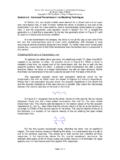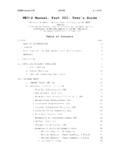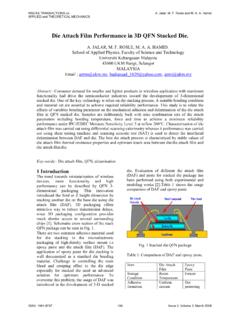Transcription of Initial Plant Assessment Report - RATCH - Australia
1 1 | P a g e Initial Plant Assessment Report Modelling and Optimisation Report (Public Release Version) RATCH - Australia Collinsville Solar Thermal Power Station 2 | P a g e Contents Introduction .. 3 Preliminary financial model .. 4 Technical Modelling and Optimisation Report .. 4 Overview .. 4 Key Findings .. 4 Marginal Loss Factor Analysis Report .. 5 Overview .. 5 Modelling Assumptions & Outcomes .. 6 Constraint Analysis .. 9 3 | P a g e INTRODUCTION RATCH - Australia Corporation Limited (RAC), in partnership Transfield Infrastructure Pty Limited, and The University of Queensland (UQ), is undertaking all the preparatory development work to assess the viability of converting an existing 180MW coal fired power station to a 30MW hybrid solar thermal / gas power station at the existing Collinsville Power Station (CPS) in Queensland (the Project).
2 As a part of the Measure, RAC will also examine the feasibility of using Novatec s Supernova Linear Fresnel Solar Thermal technology to generate superheated steam to be supplied to steam turbine/s to provide grid connected electricity. The dual-fuel boiler will also be designed to use natural gas to enhance grid reliability from the Project. The Australian Government, through an Australian Renewable Energy Agency s (ARENA) Emerging Renewables Program Funding Agreement, is providing $ million in funding for the completion of the feasibility study. One of the key deliverables for this Modelling and Optimisation Report for public release, which contains a summary of the non-commercially sensitive information from the following sections: Preliminary Financial Model: RAC has developed a Preliminary Financial Model comparing four different options for this project.
3 Existing Power Block with Gas New Power block without Gas Existing Power Block with Gas boiler New Power block with Gas boiler Technical-Modelling and Optimisation Report : RAC s technical advisors, Parsons Brinckerhoff, have completed a modelling and potential Plant optimisation which includes: Overall Plant technical model Calculations of fuel consumptions, water balance, Plant emissions, and field losses Preliminary generation profile Marginal Loss Factor Analysis Report : RAC engaged ROAM Consulting (ROAM) to conduct a Marginal Loss Factor (MLF) Assessment for the proposed Collinsville Solar project 4 | P a g e PRELIMINARY FINANCIAL MODEL The preliminary financial model developed by RAC to compare the potential options for the Project indicates the New Power Block with Gas Boiler has the lowest projected levelised cost of electricity. The preliminary financial model does indicates: that the facility will have a levelised cost of energy (LCOE) amongst the lowest in the world to date for a solar hybrid power station.
4 A new Power Block with Gas Boiler has the lowest projected levelised cost of electricity. [Details excluded as commercially sensitive] TECHNICAL MODELLING AND OPTIMISATION Report OVERVIEW RAC engaged Parsons Brinckerhoff to provide a modeling and optimization Report . As part of this investigation, a commercial and technical comparison has been made between 1) utilising the existing power block or 2) the installation of new Plant to establish the power block. This Report considers the modelling and potential Plant optimisation of these two options to establish projected generation yields. The outcomes of this modelling and optimisation Report have been used as part of a full life cycle financial evaluation described in the following section. KEY FINDINGS The results from the modeling and optimization study clearly indicate that adopting a new power block approach located in near vicinity to the existing CPS provides substantial performance benefits compared to the refurbishment option.
5 The advanced design incorporated in a modern steam turbine generator and integrated equipment provides various benefits, including: significantly improved levels of overall cycle efficiency can be obtained by use of a two cylinder reheat turbine with a moisture separator reheater (MSR) specifically designed and engineered for solar applications fast start-up capability and improved loading cycling performance which again improves the generation yield; and the solar to electrical conversion efficiency is very high with limited use of the fossil fuel. The energy yield modelling based on the configuration for both the existing refurbished power block and the new power block has predicted the electricity 5 | P a g e production and fuel consumption figures given in Table 1. Both these configurations include the fossil fuelled boiler and are based on same overall sized solar field.
6 The major difference between the two plants relates to the cycle efficiency and corresponding generation yields. The new Plant would represent nearly a 20% improvement in efficiency compared to the refurbished Plant , which, for the same sized solar field and boiler, would mean 21% less fossil fuel consumption, 30% less water use and a 14% increase in solar generation. Table 0: Key performance parameters Existing Power Block New Power Block Steam conditions MPa & 454 C 12 MPa & 500 C Maximum solar cycle efficiency 32% Maximum fossil fuel cycle efficiency (LHV basis) (LHV basis) Total mirror area 202,230 m2 202,230 m2 Full load thermal input (approx.) MW MW Maximum solar output 30 MWe 33 MWe Maximum hybrid output 30 MWe 30 MWe Annual solar electricity production GWh GWh Annual fossil fuel electricity production GWh GWh Total annual electricity production GWh GWh Annual Water Consumption 371 Ml 253 Ml MARGINAL LOSS FACTOR ANALYSIS Report OVERVIEW RAC engaged ROAM Consulting (ROAM) to conduct a Marginal Loss Factor (MLF) Assessment for the proposed Collinsville Solar Thermal project.
7 The project MLFs have been assessed for eleven (11) years being 2015-16 to 2025-26 inclusive. The years 2015-16, 2017-18, 2020-21 and 2025-26 were investigated in detail with the intervening years estimated through interpolation. For the final year (2025-26) ROAM performed upside and downside sensitivity studies. 6 | P a g e MODELLING ASSUMPTIONS & OUTCOMES The proposed solar thermal project is to be situated at the current Collinsville power station site. The Collinsville 132 kV substation will be the likely connection point to the transmission system for both the Collinsville solar thermal and proposed Collinsville solar PV projects. As the proposed solar PV project has the capacity to affect the projected MLF for the solar thermal project, a project specific and a combined MLF have been modeled. For completeness ROAM has included the individual volume weighted MLFs for the solar PV and thermal units.
8 However, it is highly likely that as both units connect to the same bus for MLF calculations, AEMO will provide a single volume weighted MLF based on the total station output. The single combined MLF has been used in the financial Assessment of the Collinsville solar thermal project. The volume-weighted MLFs calculated by ROAM for the Collinsville solar thermal project in the Base, Upside and Downside cases are listed in Table 2 and shown graphically in Figures 1 and 2. Table 2 Collinsville Solar MLF Outcomes Site Connection Arrangement 2015-16 2017-18 2020-21 2025-26 Downside Base Upside Collinsville Solar PV and Thermal Combined Table 2 above shows that for the years 2015-16, 2017-18 and 2020-21 the MLF for the site is relatively stable. This can mainly be attributed to the growth in North Queensland demand being met by additional new entrant generators, such as the Crediton and High Road wind farms and in some cases additional generation from existing stations.
9 A forecast MLF of for 2015-16 aligns well with expectations with the retirement of the Collinsville Power Station. The decrease in MLF from 2015-16 to 2017-18 is a result of the introduction of the solar thermal component of the project and the Crediton wind farm near Nebo depressing the MLF down to The slight increase in MLF from 2017-18 to 2020-21 is a result of demand growth in the NQ area. This is partially offset by the increased generation from Mt Stuart, which generated approximately 70 GWh/yr. in the earlier years increasing to 200 GWh/yr. in 2020-21. The significant increase in MLF for the base case from 2020-21 to 2025-26 is a result of local demand growth with no corresponding increase in local generation or new entrant power stations. Also note that no significant transmission augmentations along the 275 kV transmission backbone have been included for this forecast period.
10 7 | P a g e If a significant network augmentation were to eventuate is would likely depress the MLF, by reducing losses in the transfers from Central Queensland to North Queensland. The Upside case shows the resulting MLF for the project with a reduction of 210 GWh of local generation in the NQ area. The reduction in generation is mostly attributed to a reduction in the output of the bagasse fired power stations. Achieving a MLF above for this project would be challenging with the existing network arrangement and generation profiles of both the Collinsville Solar project and surrounding generators. Increasing the MLF for the project will mostly be outside the direct control of the Collinsville Solar project operators. Increases in MLF will mostly be attributed to local demand growth and deferral of new entrant power stations.





